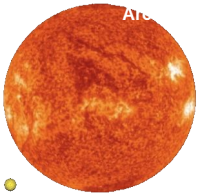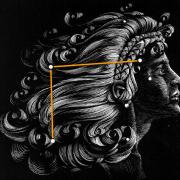With the introduction of BST it is after 21:00h before skies grow fully dark, by which time many of the seasonal constellations associated with winter are on the verge of departing. Spring groups now occupy much of the sky to the south and east. Of the star groups arranged in the south, three are associated with the labours of Hercules; Cancer, Hydra and Leo (covered in detail, see The Lion and the Serpent.)

Artist's impression of Spica:
hot, massive, double-star system
distorted as they whirl around
each other every 4 days
Following the celestial Lion across the sky, Virgo, is ranked second to Hydra in size and contains the first magnitude star, Spica (mag 0.97). Spica looks like one star, but it is at least two stars, both larger and hotter than our sun, orbiting only 18 million kilometers (11 million miles) apart. Their mutual gravity distorts each star into an egg shape, with the pointed ends facing each other as they whirl around, completing a single orbit in only four days. The stars reside around 262 light years away and are at least 300 times more luminous than our Sun. The surface temperatures are estimated at 22,400 K and 18,500 K for the larger and smaller components, respectively.
The outline of Virgo has been likened to that of a large distorted letter ‘y’ with Spica situated at the bottom of the ‘leg’. According to one legend Virgo represents Demeter; mother goddess of Earth, whose daughter, Persephone, after being pierced in the heart by one of Eros’s love arrows, was forced to return to the underworld ruled by Hades, who instantly fell in love with her. Hearing the cries of her daughter, Demeter searched the world over without success, cursing the ground so that no crops would grow. Eventually Demeter learned of the whereabouts of Persephone and begged Zeus to free her. However Persephone was only allowed to return to Earth’s surface for six months in the year – spring and summer, descending back down into the underworld for autumn and winter, a reflection of when Virgo is visible in the sky.
The area of sky within the ‘bowl of Virgo’ and extending up toward Coma Berenices is known as the realm of the galaxies, a window onto the wider universe. Through this window we are looking toward several galaxy clusters belonging to our local super cluster. The Virgo cluster lies some 40-60 million light years distant, with the more remote Coma galaxy cluster approximately 300 light year distant.
Although Berenices consists of just a smattering of stars, it is one of the original 48 constellations, said to represent the amber tresses of Queen Berenices II. She was sister too and wife of King Ptolemy III of ancient Egypt. Berenices vowed to cut off her beautiful hair and place the tresses in the temple of Venus on the safe return of her husband from war with the Assyrians. The King was victorious and the Queen duly kept her promise, but the tresses disappeared from the temple, according to the court astronomer, Conon, removed by Zeus himself, honouring the donor by placing them in the sky.
To the naked eye Coma may be rather inconspicuous, however it is rewarding to explore with many pleasing cascades of fainter stars visible in a telescope or pair of binoculars. A modest instrument (4 inch diameter) will yield several of the brighter galaxies and 15 are listed in the Messier catalogue. All of the galaxies appear as elliptical or elongated smudges. Larger amateur scopes reveal at least a couple of dozen galaxies, one reason why amateur astronomers stretch their patience to the limit when peering through this window.
Our final destination, Bootes, pronounced Bo-eh-tes, is currently visible in the ESE. The outline of the constellation resembles that of long kite, dented somewhat on one side. Its chief star, brilliant Arcturus, resides at the foot of this pattern. The name Arcturus comes from the Greek meaning “guardian of the bear” due to its relative proximity to the Great Bear. According to legend Bootes was the son of Demeter and was rewarded with a place in the heavens for having invented the Ox driven plough.
 Arcturus itself is the second brightest star visible from Britain and has a lovely deep amber hue. At a distance of just 37 light years, Arcturus is the nearest example of an orange giant star, cooler, older and larger, around 30 times greater in diameter and 113 times more luminous. Arcturus is an example of a star post Helium flash, one that now fuses Helium in its core. It may continue to do this for another 100-150 million yrs before expanding yet again eventually becoming a planetary nebula and white dwarf. In the distant future our Sun will evolve into a star resembling Arcturus. From the UK, Arcturus (mag -0.04) is the second brightest star visible after Sirius, but remains in our skies for much longer – approx 9 months
Arcturus itself is the second brightest star visible from Britain and has a lovely deep amber hue. At a distance of just 37 light years, Arcturus is the nearest example of an orange giant star, cooler, older and larger, around 30 times greater in diameter and 113 times more luminous. Arcturus is an example of a star post Helium flash, one that now fuses Helium in its core. It may continue to do this for another 100-150 million yrs before expanding yet again eventually becoming a planetary nebula and white dwarf. In the distant future our Sun will evolve into a star resembling Arcturus. From the UK, Arcturus (mag -0.04) is the second brightest star visible after Sirius, but remains in our skies for much longer – approx 9 months
Organizers for the Chicago World's Fair in 1933 were searching for a memorable way to open their exhibit, and hit upon the idea of using its star light. At 21:15h Central Time on May 27, 1933, telescopes focused the star's light on several photoelectric cells. The current was used to flip a switch that turned on the floodlights at the expedition grounds.
Of the brighter stars visible in the sky, Arcturus has by far the greatest ‘proper’ or true movement as seen against the background sky, indeed Arcturus appears to move a distance equivalent to the Moons diameter every 1000 years. This is because it is plunging through the galactic plane, cutting across the path of the Suns trajectory as it orbits around the Milky Way.
Initially Arcturus will appear even brighter in our skies, but thereafter will rapidly diminish in brilliance, and in a few thousand years will become just another anonymous face in the stellar crowd!
- Log in to post comments



